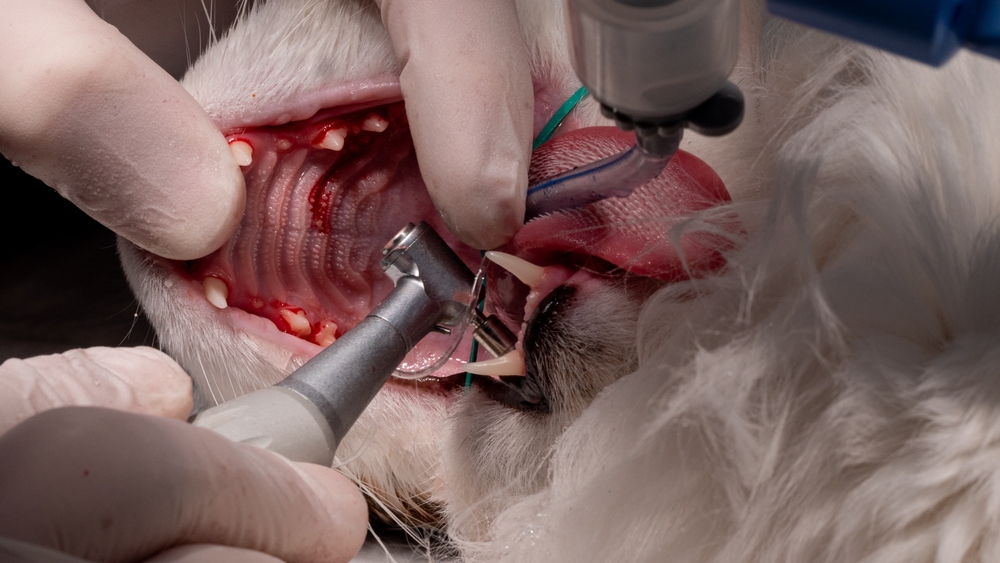Oral health is essential to your cat’s well-being. However, dental conditions can be easily overlooked, because cats often hide pain and other problem signs. One common and painful dental issue that affects many cats is feline tooth resorption, which goes by the acronym FORLs (feline odontoclastic or oral resorptive lesions). The Mobile Cat & Dog Clinic team shares how to spot painful oral lesions in cats and what you can do to improve your affected cat’s comfort.
What is feline tooth resorption?
FORLs cause the tooth structure to break down and the body resorbs the tooth minerals and tissues. Veterinarians aren’t sure why the lesions occur, but they can affect cats at any age and often appear in a symmetrical, characteristic pattern. A FORL typically starts at the gum line, appearing as a small red bump or inflamed gum tissue. Resorption then creates a defect in the hard outer tooth layers and exposes the sensitive inner nerves and tissues. Eventually, the resorption progresses downward into the tooth root, causing the crown to break, become loose, or fall out.
Feline tooth resorption signs
FORLs are extremely painful, because they expose the tooth’s nerves, causing painful jolts and discomfort each time water or a food particle touches the area. However, detecting FORLs can be challenging, as many cats are adept at hiding pain. Some cats display the following signs:
- Difficulty eating
- Drooling
- Bad breath
- Red or bleeding gums
- Missing tooth crown
- Jaw chattering
Diagnosing feline tooth resorption
FORLs may be diagnosed or suspected based on an awake oral examination. Brushing a cotton swab along the gumline may result in jaw chattering because the exposed tooth nerve is irritated. Definitive and early diagnosis requires anesthesia and dental X-rays to evaluate the entire tooth structure, especially the root. In some cases, the veterinary team discovers one or more FORLs during a routine or preventive professional dental cleaning.
Treating feline tooth resorption
Unfortunately, the tooth resorption process cannot be reversed. Once a tooth becomes damaged and painful, extraction is the only option to restore comfort. In some cases, only the tooth’s crown is removed and damaged root remnants, which can be difficult to retrieve, are left behind and continue to resorb.
Although tooth resorption eventually stops on its own when the tooth structure has completely dissolved, the process can take many months and causes concerns over quality of life. For cats who cannot undergo anesthesia or who are nearing the end of their life, consider speaking with our team about palliative care options to improve comfort.
Preventing feline tooth resorption

The exact cause of FORLs remains unclear, which means we aren’t sure how to prevent them effectively. Around three-quarters of cats 5 years and older experience one or more resorptive lesions, which can occur independently or in conjunction with other dental diseases (e.g., periodontal disease). The best defense against FORLs is early detection and treatment via annual veterinary visits and routine dental cleanings. Brushing your cat’s teeth or using other oral hygiene products can help promote overall oral comfort and reduce oral bacteria. However, brushing can be painful for cats with active resorptive lesions, so do not implement a home care regimen until an x-ray examination and routine professional cleaning have been performed.
Feline tooth resorption can contribute to declining quality of life in senior cats. When possible, treating FORLs is recommended to restore comfort, as allowing the resorption process to progress unchecked causes intense pain. The Mobile Cat & Dog Vet team can help cat owners implement pain control and lifestyle changes to address painful oral lesions for cats in the end-of-life care stage. Contact us to learn more about our senior, hospice, and palliative care services or to schedule a home visit and quality of life evaluation.








Leave A Comment